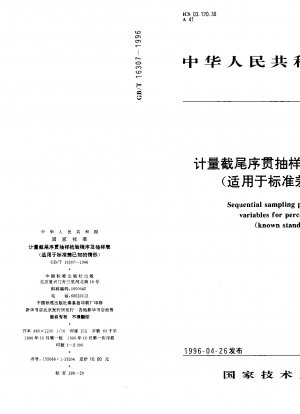GB/T 16307-1996
Sequential sampling plans for inspection by variables for percent nonconforming (knownstandard deviation) (English Version)
- Standard No.
- GB/T 16307-1996
- Language
- Chinese, Available in English version
- Release Date
- 1996
- Published By
- General Administration of Quality Supervision, Inspection and Quarantine of the People‘s Republic of China
- Latest
- GB/T 16307-1996
- Scope
- This standard specifies the measurement censored sequential sampling inspection program and procedures for discrete individuals. The censored sequential sampling plan (referred to as the sequential plan) in this standard is applicable to the situation where the number of unqualified products per hundred units of products is used as the quality index, and the quality characteristics of the inspected products obey the normal distribution, and the standard deviation σ is known. . The sampling plan in the standard is indexed by producer-side risk-quality and consumer-side risk-quality. The sequential plans and procedures in Appendix A are indexed with the acceptable quality level AQL, mainly to match the sampling plan system in GB 6378-86. This International Standard provides procedures for the sequential evaluation of test results. It can make the probability of acceptance very low when the batch quality of the product provided by the manufacturer does not meet the specified requirements, prompting the manufacturer to provide a product with a higher batch quality, and at the same time protect the use by specifying the upper limit of the acceptance probability of the batch with poor quality square. This standard provides the method that saves the most sample size under the same judgment accuracy. It is suitable for the inspection of a unit product that takes a short time, the inspection of isolated batches, and the batch size is large. In particular, the batch size of the inspection batch is required to be greater than or equal to 7 times. Censored sample size. Note 1 When the batch size of the inspection lot is less than 7 times the censored sample size, that is, N<7nt, this sampling plan standard can still be used, but at this time the risk of the producer and the risk of the user are smaller than the values determined in the standard. 2 If the censored sample size exceeds the inspection lot size, the sequential protocol will use the batch size as the censored sample size value. The sampling plan in this standard is designed on the basis that the following conditions are met. a) When the inspection procedure is applied to consecutive batches, all products in each batch shall be produced by the same manufacturer using the same production process. If there are multiple producers, this standard shall be applied to each producer separately. b) Only a single quality characteristic of the product is considered, and the value of this quality characteristic can be measured on a continuous scale. If several quality characteristics of the product are important, then use this criterion separately. c) The production is stable, i.e. its quality characteristic values follow a normal distribution or approximately follow a normal distribution and the standard deviation is known. d) The upper specification limit U, or the lower specification limit L, or the two-sided specification limits U and L of the quality characteristics of the product specified in the contract or standard. If the upper specification limit U is specified, when the quality characteristic value x>U measured for an individual, the product is considered to be unqualified; if the lower specification limit L is specified, when the quality characteristic value xU or x<< l, that the product is substandard. For two-sided specification limits, it is also divided into two cases: separate two-sided specification limits or comprehensive two-sided specification limits according to whether the risks of each side are considered separately or the risks of both sides are jointly considered. < td="">
GB/T 16307-1996 history
- 1996 GB/T 16307-1996 Sequential sampling plans for inspection by variables for percent nonconforming (knownstandard deviation)
